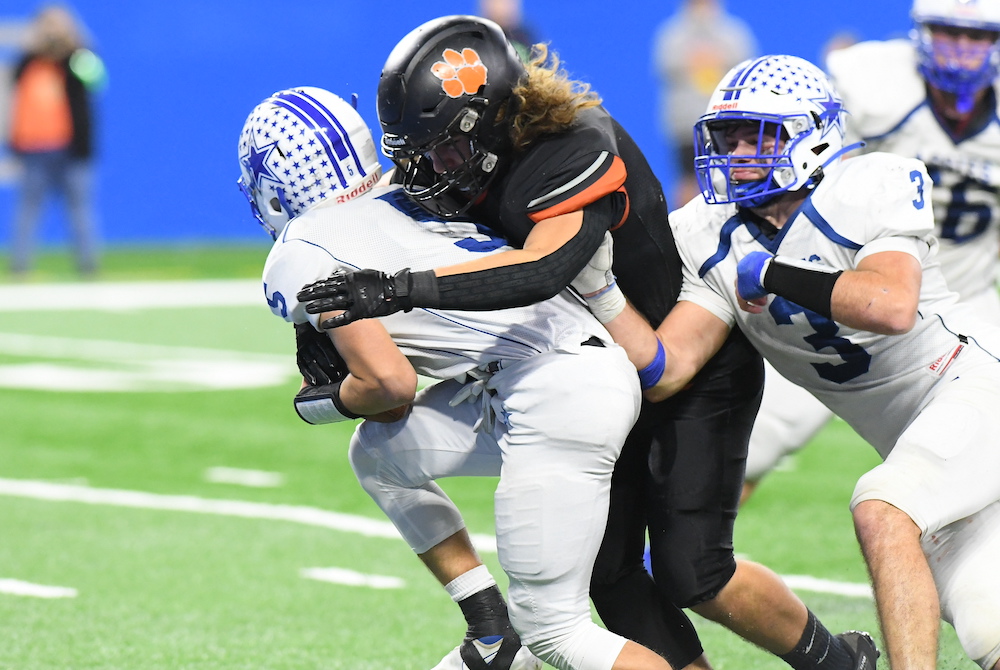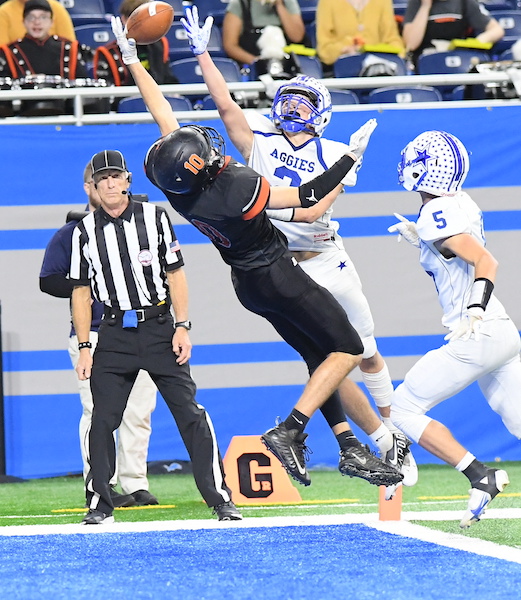
Michigan’s Football Numbers Game – Corrected
September 1, 2017
Today’s blog was written by MHSAA Second Half Editor Geoff Kimmerly
The demise of Michigan high school football has been greatly exaggerated – or, at least, recently misreported by one of the U.S.’s most recognizable newspapers that noted as part of a larger story on football decline that Michigan has seen a “net loss of 57 teams in the past five years.”
It’s easy to understand how this error took place – especially when a reporter is not familiar with the football landscape in our state – but that doesn’t make this statement any less misleading, or harmful considering the story since has been picked up by multiple large news organizations. So let’s quickly clear up the misinterpreted information:
-
The data that led to this error came from an annual participation report released by the National Federation of State High School Associations (NFHS). Every spring, state associations (like the MHSAA) from every state and Washington, D.C., tally up how many of their member schools have a sport and how many athletes play it.
-
For 2016-17, the MHSAA submitted to the NFHS a total of 580 schools with 11-player football – that number actually includes all schools that reported having at least one football player, including primary and secondary schools in co-ops. And yes, that 580 is 57 fewer than the 637 11-player schools the MHSAA submitted for 2012-13.
-
But saying Michigan has lost 57 football programs misses out on something incredibly significant – the MHSAA also submitted 60 schools with 8-player football last year, up from 16 in 2012-13, making that net decrease in football schools over five years 13 – far fewer than 57.
And with a few more brush strokes, the picture of football in our state actually shows a healthy landscape:
-
The 640 schools in Michigan with at least one football player for 2016-17, 11 and 8-player combined, is actually eight more than we reported to the NFHS four years ago and 10 more than three years ago.
-
A better picture of Michigan’s football consistency is shown by how many varsity programs are taking the field. This fall, that number is 616 – 555 11-player varsities and 61 8-player – and we also had 616 for most of the 2016 season, 616 in 2015 and 615 in 2014.
-
We’ve had programs bring back varsity teams this year, and in one case a school has a team on its own for the first time. Benzonia Benzie Central and Suttons Bay were unable to field varsities in 2016, but Benzie Central is back playing 11-player and Suttons Bay is back with an 8-player team. Brimley, an 8-player school going back to 2010, also is fielding a team again after being unable to do so last year. Mount Clemens played only two varsity games in 2016 and forfeited a third, but has seven scheduled for this fall and lost close in its opener last week. And Bear Lake, previously a secondary school in a co-op program, now has a team all its own for the first time and is playing at the 8-player level.
-
Yes, there has been a decrease in Michigan high school football participation when it comes to the number of players – for reasons we discuss frequently, including more extracurricular/entertainment options than ever for students, more who are specializing in other sports and safety fears that often are misplaced. But we’ve also seen a three percent drop in enrollment at MHSAA member schools over the last five years. And despite that trend, Michigan again had the sixth-highest 11-player football participation in the nation in 2016-17 (and seventh-highest in 8-player) while ranking 10th nationally in number of residents of high school age.
-
So yes, while a nine percent drop in the number of football players over the last five years in Michigan clearly is troubling, and something we’re working with the Michigan High School Football Coaches Association to reverse, let’s also put those numbers in perspective. At medium-sized to bigger schools, it could mean a roster of 40 might have only 36 players. A roster of 20 at an 8-player school might go down to 18. Neither would signal the need to eliminate a football program.
-
And that move by so many schools to 8-player? It definitely started as a way for low-participation programs to keep football (and has worked for most of them). While that still may be the driving force as schools move from 11 to 8, others have made the switch because most of their former opponents did and joining them makes scheduling easier and travel shorter. Michigan has a multitude of small towns, and you’ll find most of these 8-player programs in pockets in the thumb, southwest or northern Lower Peninsula, or Upper Peninsula. And keep in mind, only Class D teams remain eligible for the 8-player playoffs – and only two of 61 teams playing 8-player this fall are larger than Class D and its enrollment limit of 203 students for 2017-18.
The story behind “a decrease of 57 schools” clearly is a little complex to explain and explain away, but it’s necessary to do so.
Yes, Michigan’s total number of football players is down a few percent. But the sport’s prominence and importance in our schools and communities remains high.

Hudson Rides Dominating Defense to Lock Down Division 8 Title
By
Paul Costanzo
Special for MHSAA.com
November 26, 2021
DETROIT – For a team not used to giving up points – or yards, for that matter – it would have been easy Friday for Hudson to make some big changes at halftime to slow down a Beal City offense that had found success through the passing game.
But the Tigers – who entered the MHSAA Division 8 Final having allowed 107.7 yards and less than a touchdown per game through the Semifinals – didn’t stray from the gameplan.
“Honestly, (the adjustment was) just keep playing,” Hudson coach Dan Rogers said. “They did a great job, their line, we couldn’t get pressure on the quarterback. He could get out on the edge and we struggled getting to him. That made us cover a lot longer than we want to, so we were trying to get to the quarterback a little bit more, keep the receivers in front of us and make plays on the football.”
It worked, as Hudson smothered Beal City in the second half, allowing just 17 yards over the final 24 minutes of its 14-7 victory at Ford Field to claim its second Finals title.
“I can’t even describe it yet; it hasn’t really hit me yet,” said Hudson senior running back and safety Bronson Marry, who had a crucial late-game interception. “I’m just waiting to walk out of the locker room and find our families. It’s going to (hit like) a brick wall.”
While Hudson (14-0) never led by more than one score, Beal City never threatened to overcome it, spending the entirety of the second half offensively on its own side of the field. The Aggies’ five second-half possessions went for 4, -6, 13, 1 and 5 yards, and totaled 5 minutes and 29 seconds.
A fumble, an interception and downs ended the last three drives, with Nick Kopin breaking up the final Beal City pass attempt with 1:51 to play, sealing the game. It was a fitting end to Kopin’s big day, as he also had forced a fumble earlier in the fourth quarter and rushed for 131 yards and both of Hudson’s touchdowns.
“It’s amazing,” Kopin said. “Obviously, I’m going to credit all my runs to our offensive line and our play-calling by coach (Jeremy) Beal. It set up really good cutbacks, and they were blocking real well. Defensively, credit to (Coach Rogers), he’s very strict on us reading our keys and doing our jobs. I think all of us, including myself, just did that, and the game turned out in our favor.”
 Kopin’s second score, a 2-yard run, came with 6:58 to play and put the Tigers up 14-7. The two-point pass was no good, however, keeping Beal City within a touchdown. The Aggies received a further boost with the return of quarterback Hunter Miles, who had been injured midway through the third quarter, but Hudson’s defense didn’t allow for a storybook comeback.
Kopin’s second score, a 2-yard run, came with 6:58 to play and put the Tigers up 14-7. The two-point pass was no good, however, keeping Beal City within a touchdown. The Aggies received a further boost with the return of quarterback Hunter Miles, who had been injured midway through the third quarter, but Hudson’s defense didn’t allow for a storybook comeback.
“Hunter Miles is Hunter Miles; he’s a warrior,” Beal City coach Brad Gross said. “That’s Hunter Miles. Ankle, ribs, everything else (was hurt). We have a lot of guys dinged up. Cade Block’s had a (injured) shoulder that he’s been playing with for three weeks. Wade Wilson has a broken hand that he played the whole game with. We’re just banged up. We have a bunch of warriors. That’s why we’re here.”
Miles had more success in the first half, mostly on the strength of a pair of big pass plays to Carter Fussman. The first was a 53-yard touchdown pass late in the first quarter. Miles rolled to his right before finding Fussman open near the 10-yard line.
The second was a 56-yard throw and catch on the penultimate play of the first half, which came immediately after Hudson had taken an 8-7 lead on a 2-yard run from Kopin and a two-point conversion pass from Anthony Arredondo to Ambrose Horwath. The big pass play ended with Fussman being hauled down by Horwath at the Hudson 7-yard line with four seconds left in the half.
That tackle wound up being enormous, as an incomplete pass on the next play ended the half with Hudson still in the lead.
“It probably made the conversation at halftime better,” Rogers said. “It was a huge tackle. That’s what we talk about: You just have to keep playing. They’re going to make plays, things are going to happen, and it would have been just as easy to hang your head and he runs into the end zone. Our kids don’t do that, and Ambrose, he made a play, and that’s what we had to have.”
Hudson’s offense had success on the ground, rushing for 282 yards, but strong red zone defense from the Aggies kept them in the game. All five of Hudson’s second half drives – excluding the final one, which consisted of three kneel downs – ended at least within the Beal City 35, but just one led to a score.
“You have to give credit to Beal City, too,” Rogers said. “When we got down there, they stiffened up defensively and took all the inside runs away. Unfortunately, we weren’t able to score and it kept the game close.”
Payton Rogers added 62 yards on the ground for Hudson, while Horwath hauled in the lone completed pass for the Tigers, a 17-yard catch from Easten Strodtman that converted a 3rd-and-long on the Tigers’ fourth-quarter touchdown drive. Kopin led the Hudson defense with six tackles, while Strodtman and Ethan Harris each recorded a sack.
Fussman led the Beal City (12-2) offense with two catches for 109 yards, while Miles finished with 128 yards through the air – all in the first half. Josh Wilson recorded 13 tackles to lead the Beal City defense, while Miles had eight.
PHOTOS (Top) Hudson’s Easten Strodtman brings down Beal City quarterback Jack Fussman during Friday’s Division 8 Final. (Middle) The Tigers’ Ambrose Horwath (10) tries to get a hand on the ball with the Aggies’ Carter Fussman (2) and Jack Fussman defending. (Photos by Hockey Weekly Action Photos.)

